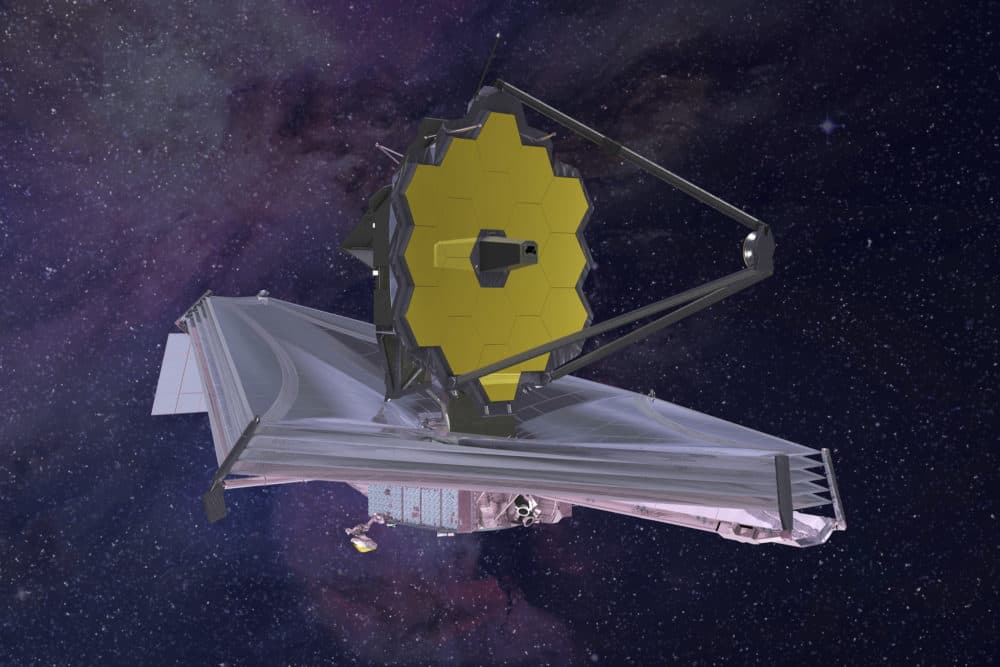Advertisement
NASA's new telescope will let astronomer Laura Kreidberg study the atmospheres of far-off exoplanets
Resume
In just a few weeks, NASA will launch the largest and most powerful space telescope ever created.
The James Webb Space Telescope is a project decades in the making — basically the entire lifetime of astronomer Laura Kreidberg. She says the new telescope will help scientists study the atmospheres of planets far beyond our solar system.
That’s what Kreidberg does as director of the Atmospheric Physics of Exoplanets department at the Max Planck Institute for Astronomy in Heidelberg, Germany.
The Hubble Space Telescope was a revelation when it launched more than 30 years ago, but Kreidberg says this new telescope is 10,000 times better than the Hubble because the mirror is much bigger. The new telescope also gives scientists wider wavelength coverage that allows them to see more colors of light.
“It's incredible that Hubble, being 30 years old, can be used for exoplanets at all,” she says. “And so James Webb is a modernized update that's bigger and better in almost every way.”
Kreidberg has already spotted some exoplanets, planets orbiting stars beyond our own solar system. Exoplanets are common: Most stars have at least one planet in orbit, and many of these planets are similar in size and temperature to Earth.
Astronomers find exoplanets by searching for planets that are passing in front of their host star, which is called a transit, she says.
“When a transit happens, the light from the star dims by a very tiny amount, often less than 1%,” she says. “And that tells us that there's a planet orbiting that star.”

The new telescope will help scientists make revolutionary discoveries about the atmospheres of distant exoplanets, Kreidberg says. Beyond curiosities about the presence of water and gasses like methane or carbon dioxide in the atmosphere, astronomers want to know whether these planets have an atmosphere at all.
“Life, as we know it on Earth, requires an atmosphere. And you can get really speculative about maybe there could be life under a surface. We think that's even a possibility in our own solar system,” she says. “But most likely, if we're going to detect signs of life from afar and recognize it, you'd need an atmosphere to do that.”
As a kid, Kreidberg pondered big questions. At age 8, she asked her mom, “Where is the edge of the universe?” She’s been stuck on that question ever since. And an explosion in discoveries of exoplanets during her college years led her to pursue this work as a career.
Astronomers like Kreidberg are also looking for volcanic activity to help answer whether Earth-size exoplanets are tectonically active, she says.
“We think that plate tectonics has played a really big role in shaping the history of life on Earth,” she says, “and detecting volcanic activity could be telltale evidence for plate tectonics occurring on another planet.”
One of the real advantages of this new telescope is that it might help scientists spot cooler planets, which may be more likely to have life on them.
Most of the exoplanets astronomers have studied are very hot, Kreidberg says. Hotter planets are easier to see in detail because they burn so brightly but it's hard to sustain life under such extreme temperatures.
“James Webb will allow us to start pushing to the much more temperate planets, planets where even liquid water is possible,” she says. “And so that's the first time that we'll be able to see these worlds in detail and learn about what their atmospheres are made out of.”
Julia Corcoran produced and edited this interview for broadcast with Todd Mundt. Allison Hagan adapted it for the web.
This segment aired on November 29, 2021.

